check engine YAMAHA YZ426F 2001 Notices Demploi (in French)
[x] Cancel search | Manufacturer: YAMAHA, Model Year: 2001, Model line: YZ426F, Model: YAMAHA YZ426F 2001Pages: 626, PDF Size: 47.57 MB
Page 236 of 626

3 - 46
INSP
ADJ
IGNITION TIMING CHECK
IGNITION TIMING CHECK
1. Remove:
lTiming plug 1
2. Attach:
lTiming light
lInductive tachometer
To the spark plug lead.
3. Check:
lIgnition timing
Timing light:
YM-33277-A/90890-03141
Inductive tachometer
YU-08036-B
Engine tachometer:
90890-03113
Checking steps:
lStart the engine and let it warm up. Let the
engine run at the specified speed.
Engine speed:
1,700 ~ 1,900 r/min
lVisually check the stationary pointer a is
within the firing range b on the rotor.
Incorrect firing range ® Check rotor and
pickup assembly.
4. Install:
lTiming plug
Page 364 of 626
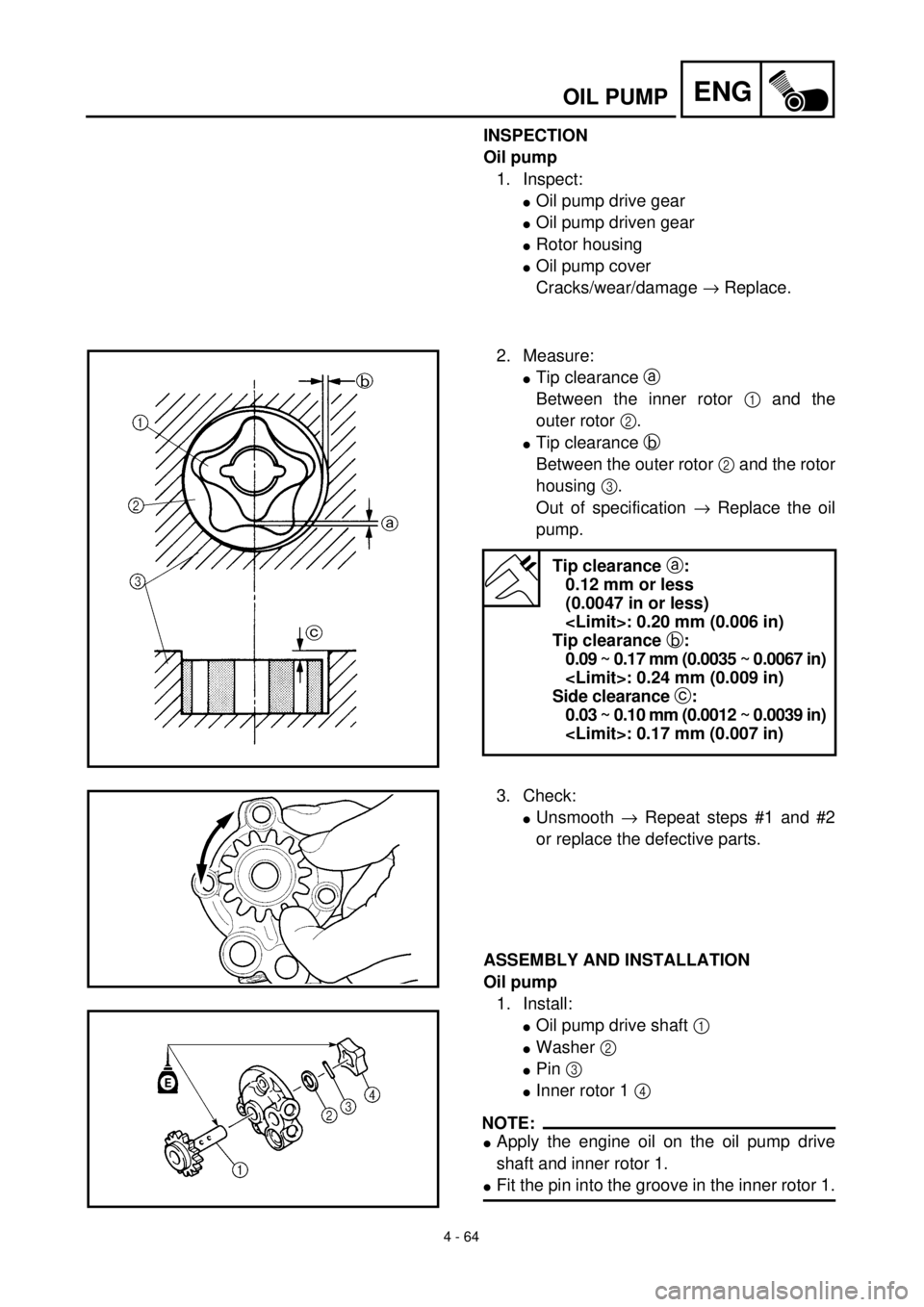
4 - 64
ENG
OIL PUMP
INSPECTION
Oil pump
1. Inspect:
l
Oil pump drive gear
l
Oil pump driven gear
l
Rotor housing
l
Oil pump cover
Cracks/wear/damage
®
Replace.
2. Measure:
l
Tip clearance
a
Between the inner rotor
1
and the
outer rotor
2
.
l
Tip clearance
b
Between the outer rotor
2
and the rotor
housing
3
.
Out of specification
®
Replace the oil
pump.
Tip clearance
a
:
0.12 mm or less
(0.0047 in or less)
Tip clearance
b
:
0.09 ~ 0.17 mm (0.0035 ~ 0.0067 in)
Side clearance
c
:
0.03 ~ 0.10 mm (0.0012 ~ 0.0039 in)
3. Check:
l
Unsmooth
®
Repeat steps #1 and #2
or replace the defective parts.
ASSEMBLY AND INSTALLATION
Oil pump
1. Install:
l
Oil pump drive shaft
1
lWasher 2
lPin 3
lInner rotor 1 4
NOTE:
lApply the engine oil on the oil pump drive
shaft and inner rotor 1.
lFit the pin into the groove in the inner rotor 1.
Page 406 of 626
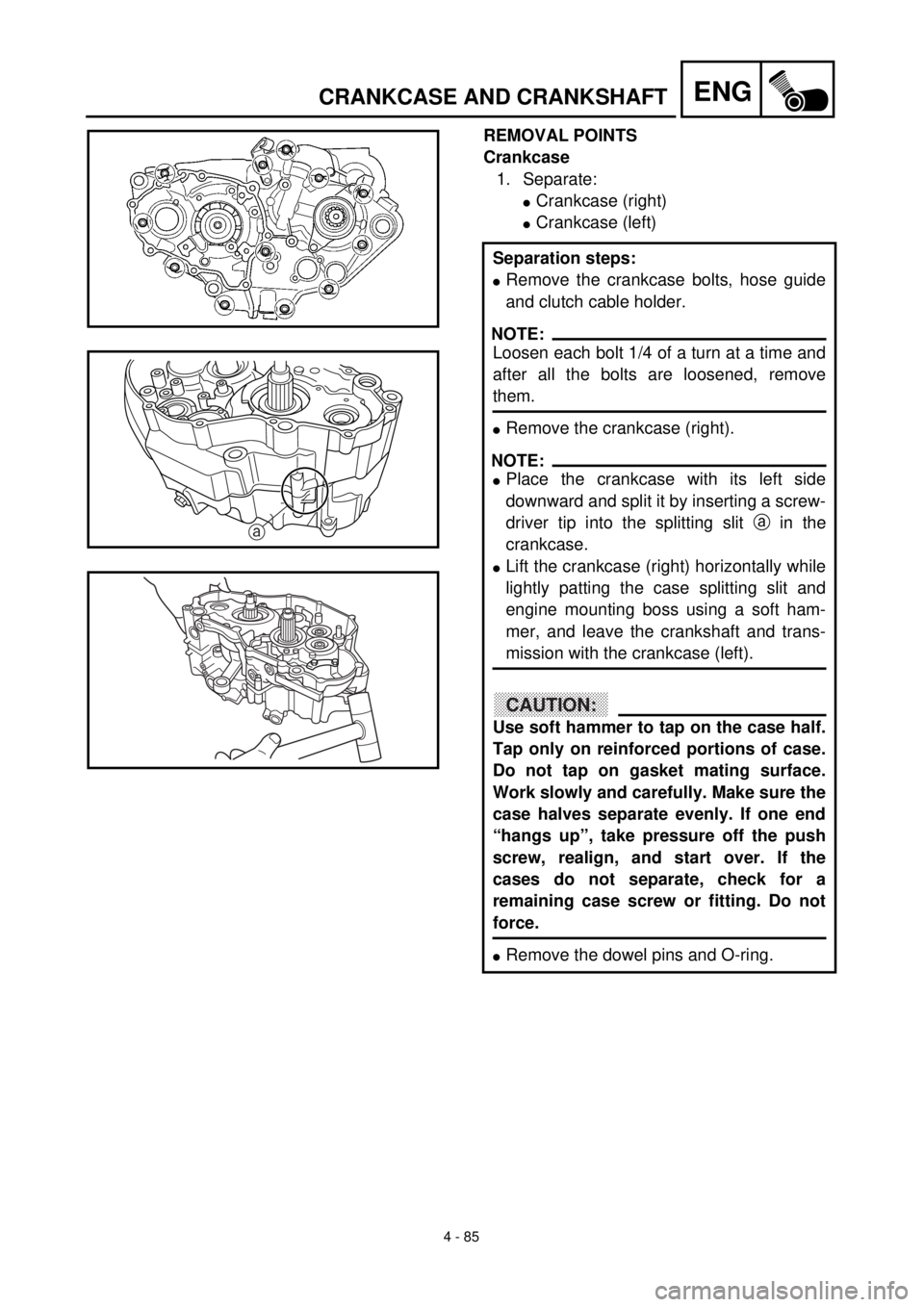
4 - 85
ENGCRANKCASE AND CRANKSHAFT
REMOVAL POINTS
Crankcase
1. Separate:
lCrankcase (right)
lCrankcase (left)
Separation steps:
lRemove the crankcase bolts, hose guide
and clutch cable holder.
NOTE:
Loosen each bolt 1/4 of a turn at a time and
after all the bolts are loosened, remove
them.
lRemove the crankcase (right).
NOTE:
lPlace the crankcase with its left side
downward and split it by inserting a screw-
driver tip into the splitting slit a in the
crankcase.
lLift the crankcase (right) horizontally while
lightly patting the case splitting slit and
engine mounting boss using a soft ham-
mer, and leave the crankshaft and trans-
mission with the crankcase (left).
CAUTION:
Use soft hammer to tap on the case half.
Tap only on reinforced portions of case.
Do not tap on gasket mating surface.
Work slowly and carefully. Make sure the
case halves separate evenly. If one end
“hangs up”, take pressure off the push
screw, realign, and start over. If the
cases do not separate, check for a
remaining case screw or fitting. Do not
force.
lRemove the dowel pins and O-ring.
a
Page 416 of 626

4 - 90
ENGCRANKCASE AND CRANKSHAFT
6. Tighten:
lHose guide 1
lClutch cable holder 2
lBolt (crankcase)
NOTE:
Tighten the crankcase tightening bolts in
stage, using a crisscross pattern.
T R..12 Nm (1.2 m · kg, 8.7 ft · lb)
7. Install:
lOil delivery pipe
lO-ring
lBolt (oil delivery pipe)
8. Install:
lTiming chain
lTiming chain guide (rear)
lBolt (timing chain guide)
9. Remove:
lSealant
Forced out on the cylinder mating sur-
face.
10. Apply:
lEngine oil
To the crank pin, bearing and oil deliv-
ery hole.
11. Check:
lCrankshaft and transmission operation.
Unsmooth operation ® Repair.
New
T R..10 Nm (1.0 m · kg, 7.2 ft · lb)
T R..10 Nm (1.0 m · kg, 7.2 ft · lb)
Page 426 of 626

4 - 95
ENG
TRANSMISSION, SHIFT CAM AND SHIFT FORK
5. Install:
l
Shift fork 1 (L)
1
l
Shift fork 2 (C)
2
l
Shift fork 3 (R)
3
l
Shift cam
4
To main axle and drive axle.
NOTE:
l
Apply the molybdenum disulfide oil on the
shift fork grooves.
l
Mesh the shift fork #1 (L) with the 4th wheel
gear
5
and #3 (R) with the 5th wheel gear
7
on the drive axle.
l
Mesh the shift fork #2 (C) with the 3rd pinion
gear
6
on the main axle.
6. Install:
l
Transmission assembly
1
To crankcase (left)
2
.
NOTE:
Apply the engine oil on the bearings and guide
bars.
7. Check:
l
Shifter operation
l
Transmission operation
Unsmooth operation
®
Repair.
Page 559 of 626
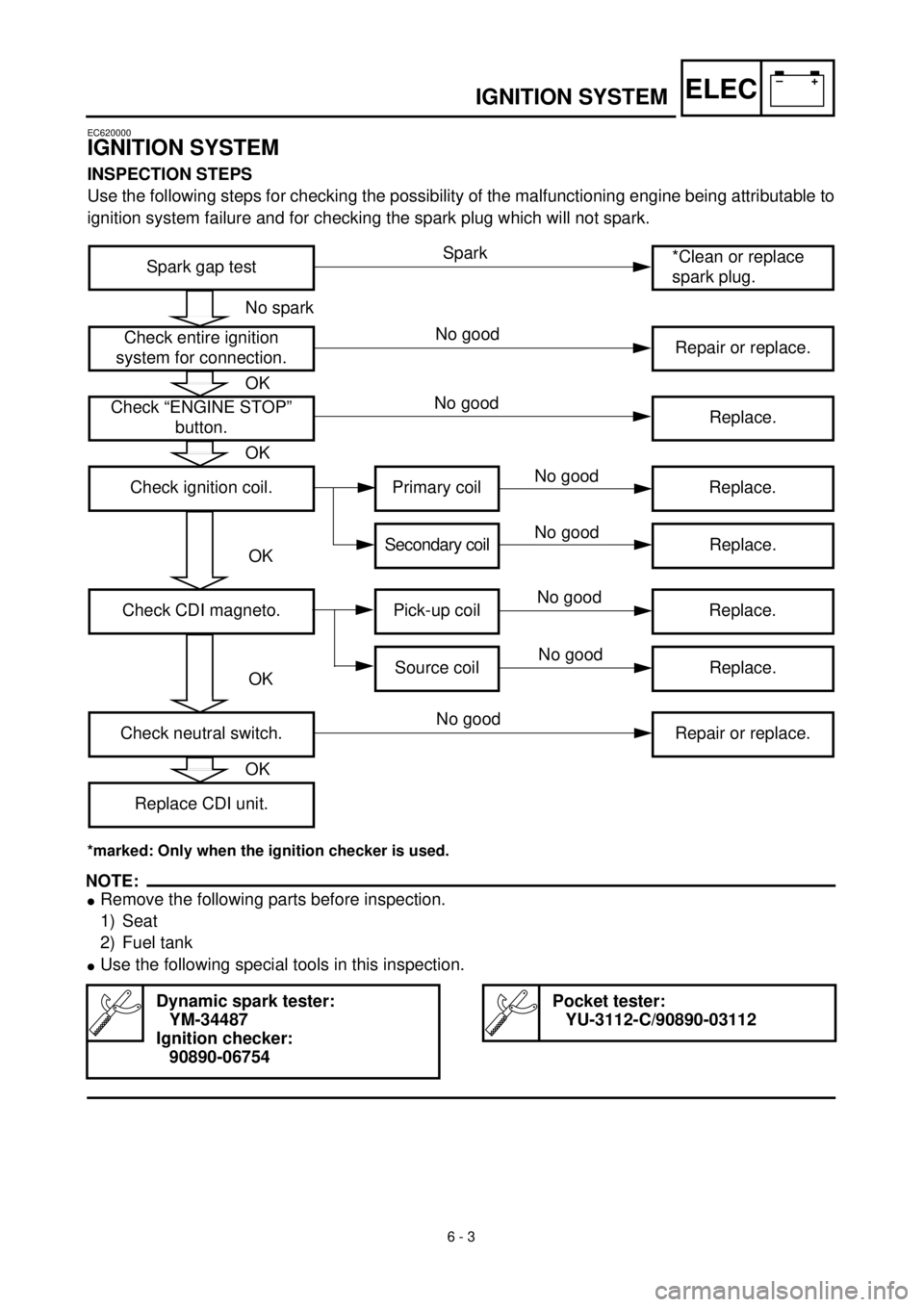
–+ELEC
6 - 3
IGNITION SYSTEM
EC620000
IGNITION SYSTEM
INSPECTION STEPS
Use the following steps for checking the possibility of the malfunctioning engine being attributable to
ignition system failure and for checking the spark plug which will not spark.
*marked: Only when the ignition checker is used.
NOTE:
lRemove the following parts before inspection.
1) Seat
2) Fuel tank
lUse the following special tools in this inspection.
Dynamic spark tester:
YM-34487
Ignition checker:
90890-06754Pocket tester:
YU-3112-C/90890-03112
Spark gap test*Clean or replace
spark plug.
Check entire ignition
system for connection.Repair or replace.
Check “ENGINE STOP”
button.Replace.
Check ignition coil. Primary coil Replace.
Secondary coilReplace.
Check CDI magneto. Pick-up coil Replace.
Source coil Replace.
Check neutral switch. Repair or replace.
Replace CDI unit.
No spark
OK
OK
OK
OK
OK
Spark
No good
No good
No good
No good
No good
No good
No good
Page 562 of 626
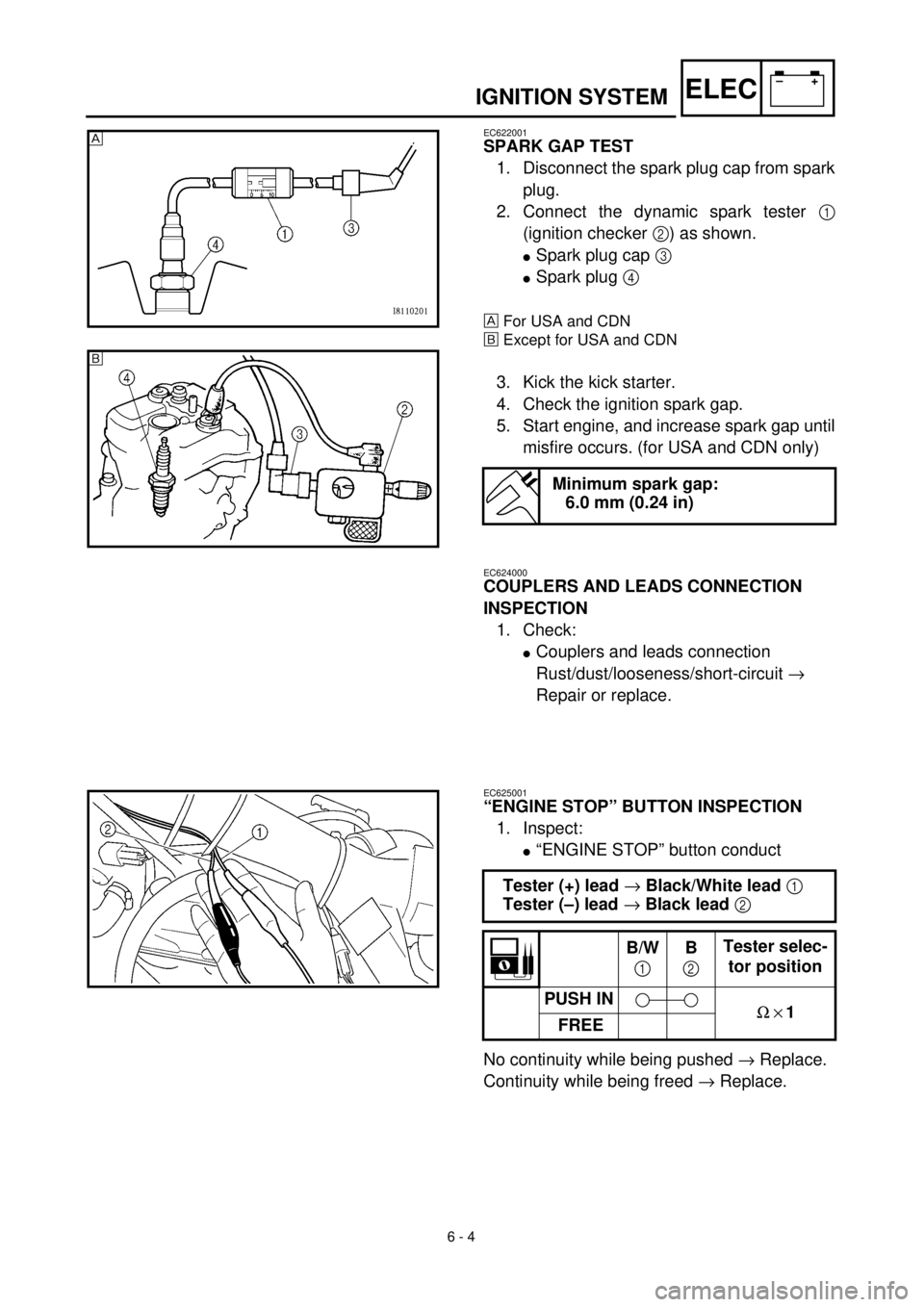
6 - 4
–+ELECIGNITION SYSTEM
EC622001
SPARK GAP TEST
1. Disconnect the spark plug cap from spark
plug.
2. Connect the dynamic spark tester 1
(ignition checker 2) as shown.
lSpark plug cap 3
lSpark plug 4
For USA and CDN
õExcept for USA and CDN
3. Kick the kick starter.
4. Check the ignition spark gap.
5. Start engine, and increase spark gap until
misfire occurs. (for USA and CDN only)
Minimum spark gap:
6.0 mm (0.24 in)
õ
EC624000
COUPLERS AND LEADS CONNECTION
INSPECTION
1. Check:
lCouplers and leads connection
Rust/dust/looseness/short-circuit ®
Repair or replace.
EC625001
“ENGINE STOP” BUTTON INSPECTION
1. Inspect:
l“ENGINE STOP” button conduct
No continuity while being pushed ® Replace.
Continuity while being freed ® Replace. Tester (+) lead ® Black/White lead 1
Tester (–) lead ® Black lead 2
B/W
1B
2Tester selec-
tor position
PUSH IN
W ´ 1
FREE
Page 568 of 626

–+ELEC
6 - 7
TPS (THROTTLE POSITION SENSOR) SYSTEM
EC690000
TPS (THROTTLE POSITION SENSOR) SYSTEM
INSPECTION STEPS
If the TPS will not operate, use the following inspection steps.
*marked: Refer to “IGNITION SYSTEM” section.
NOTE:
lRemove the following parts before inspection.
1) Seat
2) Fuel tank
lUse the following special tools in this inspection.
Pocket tester:
YU-3112-C/90890-03112Inductive tachometer:
YU-08036-B
Engine tachometer:
90890-03113
Check entire ignition
system for connection.Repair or replace.
Check TPS. TPS coil Replace.
*Check CDI magneto. Source coil Replace.
Check CDI unit.TPS input
voltageReplace.
OK
OK
OK
No good
No good
No good
No good
Page 578 of 626
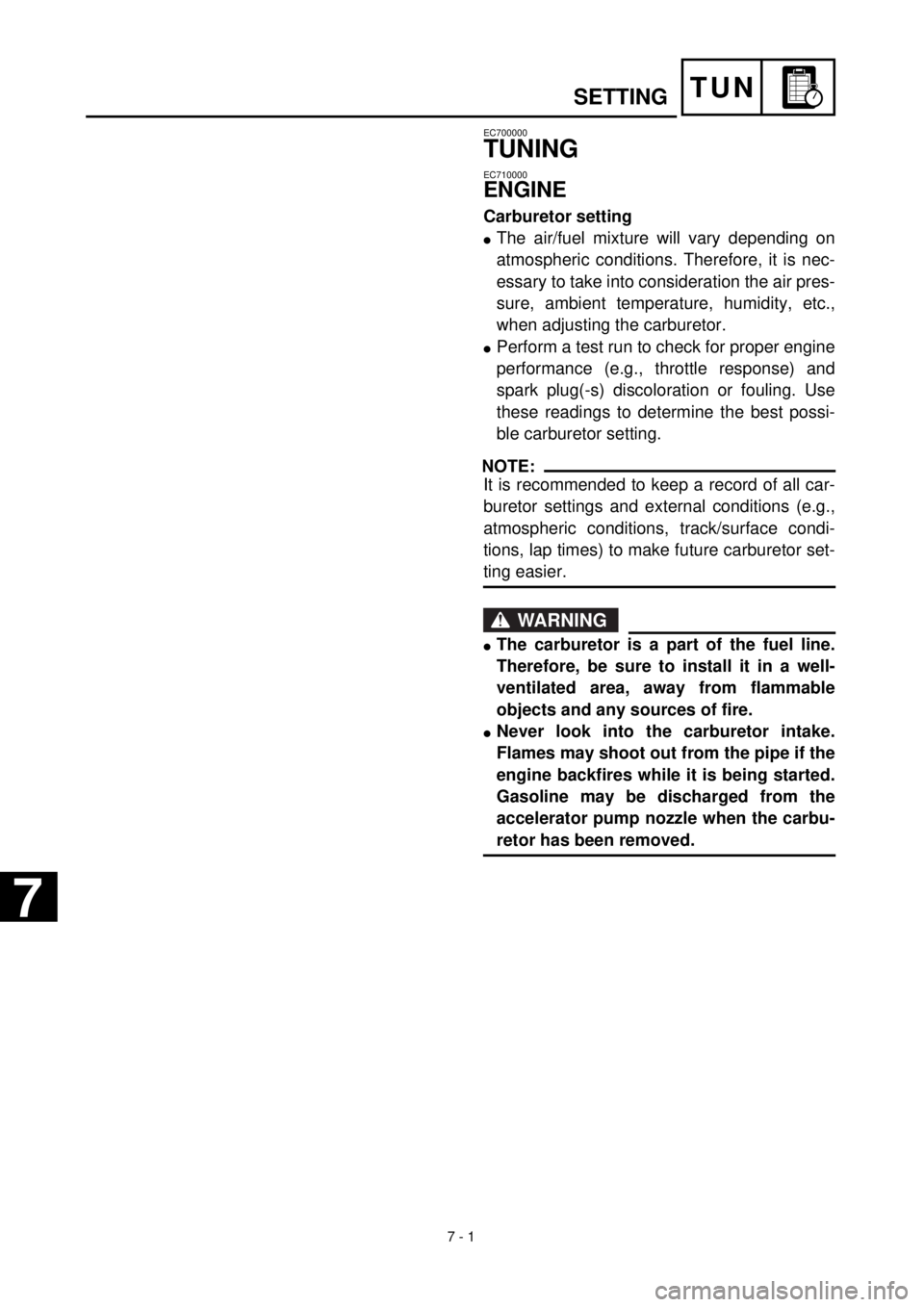
7 - 1
TUN
EC700000
TUNING
EC710000
ENGINE
Carburetor setting
lThe air/fuel mixture will vary depending on
atmospheric conditions. Therefore, it is nec-
essary to take into consideration the air pres-
sure, ambient temperature, humidity, etc.,
when adjusting the carburetor.
lPerform a test run to check for proper engine
performance (e.g., throttle response) and
spark plug(-s) discoloration or fouling. Use
these readings to determine the best possi-
ble carburetor setting.
NOTE:
It is recommended to keep a record of all car-
buretor settings and external conditions (e.g.,
atmospheric conditions, track/surface condi-
tions, lap times) to make future carburetor set-
ting easier.
WARNING
lThe carburetor is a part of the fuel line.
Therefore, be sure to install it in a well-
ventilated area, away from flammable
objects and any sources of fire.
lNever look into the carburetor intake.
Flames may shoot out from the pipe if the
engine backfires while it is being started.
Gasoline may be discharged from the
accelerator pump nozzle when the carbu-
retor has been removed.
SETTING
7
Page 580 of 626
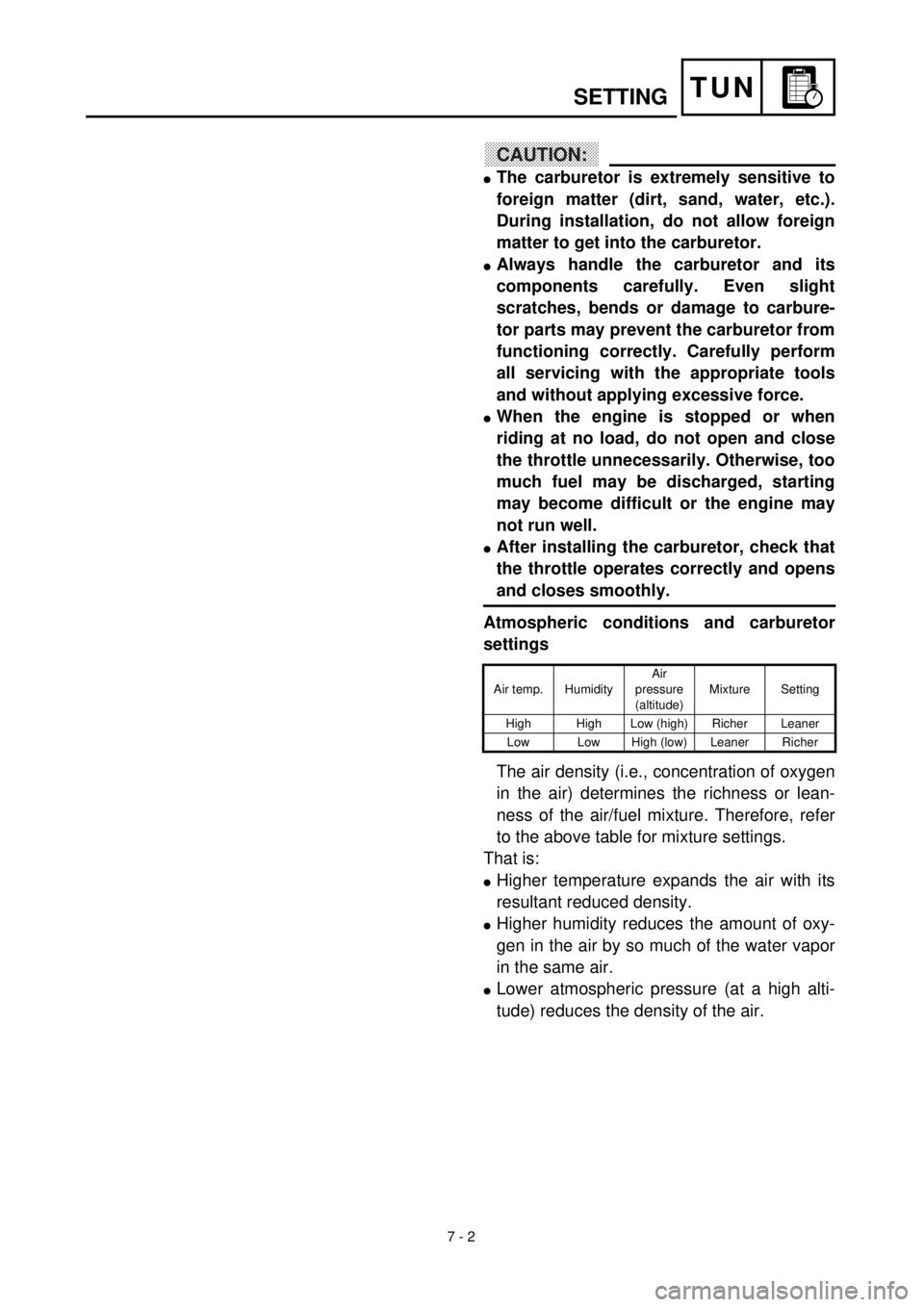
7 - 2
TUN
CAUTION:
lThe carburetor is extremely sensitive to
foreign matter (dirt, sand, water, etc.).
During installation, do not allow foreign
matter to get into the carburetor.
lAlways handle the carburetor and its
components carefully. Even slight
scratches, bends or damage to carbure-
tor parts may prevent the carburetor from
functioning correctly. Carefully perform
all servicing with the appropriate tools
and without applying excessive force.
lWhen the engine is stopped or when
riding at no load, do not open and close
the throttle unnecessarily. Otherwise, too
much fuel may be discharged, starting
may become difficult or the engine may
not run well.
lAfter installing the carburetor, check that
the throttle operates correctly and opens
and closes smoothly.
Atmospheric conditions and carburetor
settings
The air density (i.e., concentration of oxygen
in the air) determines the richness or lean-
ness of the air/fuel mixture. Therefore, refer
to the above table for mixture settings.
That is:
lHigher temperature expands the air with its
resultant reduced density.
lHigher humidity reduces the amount of oxy-
gen in the air by so much of the water vapor
in the same air.
lLower atmospheric pressure (at a high alti-
tude) reduces the density of the air.
Air temp. HumidityAir
pressure
(altitude)Mixture Setting
High High Low (high) Richer Leaner
Low Low High (low) Leaner Richer
SETTING